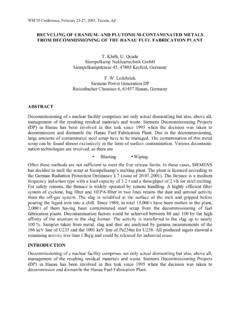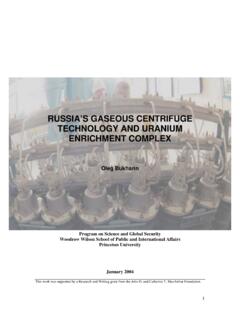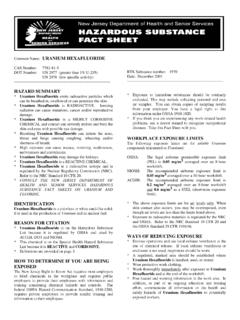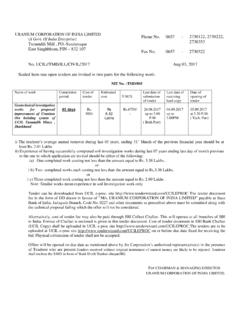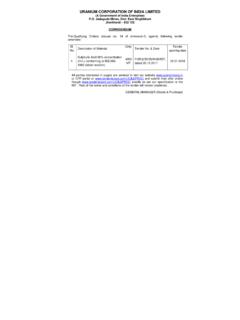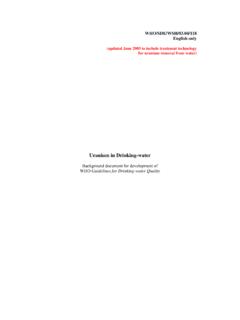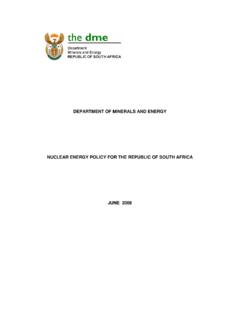Transcription of 8 The chemical toxicity of uranium 8.1 Introduction
1 678 The chemical toxicity of IntroductionThe chemical toxicity of a given elemental compound is related to the interaction of thecompound with the biochemical processes of the human body. Some of theseinteractions may be beneficial or even essential, whereas others may be detrimental. Forexample, metal ions may interact in a positive or negative way with importantfunctional sites of enzymes. Others may compete with essential metals for uptake orincorporation into proteins. Often the mechanisms of these effects are poorly understoodparticularly where different species of the same metal are likely to exist in differentenvironments within the body across a wide variety of spatial and temporal scales. Thechemical action of all isotopes and isotopic mixtures of uranium are identical, andindependent of the specific activity, because chemical action depends only on chemicalproperties.
2 Thus the chemical toxicity of natural, depleted, and enriched uranium areidentical (ATSDR, 1999). The health effects from exposure to uranium have beenrecently reviewed (WHO, 1998a and b; ATSDR, 1999; Fulco et al., 2000, Durakovic`,1999).In the 1990s, the subjective symptoms and signs of disease among Gulf War veteranshave been extensively studied, and the role of exposure to uranium as a possibleunderlying causative agent has been explored (Fulco et al., 2000; Harley et al., 1999b;CHPPM, 2000; Durakovic`, 1999).The health risks caused by chemical effects of uranium exposure, that is effects notrelated to ionizing radiation, can be assessed using the IPCS guidelines for derivation ofguidance values for health-based exposure limits (WHO, 1994), which are the basis ofthe risk estimates in the IPCS Environmental Health Criteria Document and ConciseInternational chemical Assessment Document series.
3 Tolerable intake (TI: usually expressed as mg/kg of body weight per day) in theseguidelines is defined as an estimate of the intake of a substance which can occur over alifetime without appreciable health risk . For chemicals like uranium , for which it islikely that a threshold below which no adverse health effect will occur, the approachused is based on a perceived No Observed Adverse Effect Level (NOAEL) or LowestObserved no Adverse Effect Level (LOAEL) and uncertainty factors (UF).The NOAEL is defined (WHO, 1994) as the greatest concentration or amount of asubstance, which causes no detectable adverse alteration of morphology, functionalcapacity, growth, development or life span of the target organism under definedconditions of exposure. Alterations of morphology, functional capacity, growth,development or life span of the target may be detected which are judged not to beadverse.
4 In order to derive a tolerable intake from a NOAEL, the NOAEL is divided by anuncertainty factor, which is (WHO, 1994) a product of several single factors by whichthe NOAEL or LOAEL of the critical effect is divided to derive a TI. These factorsaccount for adequacy of the pivotal study, interspecies extrapolation, inter-individualvariability in humans, adequacy of the overall database, and nature of toxicity .Components of the applied total uncertainty factor are based on best judgement fromavailable data; when no adequate data exist for a specific factor, a default value is example, for the extrapolation between species, the default uncertainty factor is 10,68which is composed of factors of for toxico-kinetic and for toxico-dynamicuncertainties. Similarly in the assessment of uncertainties associated with extrapolationbetween various human sub-populations (comprising all age groups, and healthy as wellas sick people) a default inter-individual human uncertainty factor of 10 has beenrecommended (WHO, 1994).
5 Combination of these factors leads to a total defaultuncertainty factor of 100. Other uncertainty factors may be applied to account forinadequacies in the database and/or critical study (WHO, 1994).The consideration of uncertainty factors described above relates primarily to exposureof a general population. While similar principals may be used to estimate tolerable dailyintakes for occupational exposure this has not gained general acceptance (WHO, 1994).Two reasons for this are:(i) that the more vulnerable members of the human population (children, the sickand the elderly) do not form part of the generally exposed occupationalpopulation.(ii) that workplace exposures can be controlled and for deriving occupational exposure limits for uranium and DU arepresented separately in Chapter 10 and in Annex toxicity in experimental animals and Experimental animalsInhalationThe dose response behaviour of a specific inhaled substance is highly dependent on theparticle size distribution and chemical nature of a given inhalation experiment.
6 Whilesome useful data in this respect is given in the early literature, in almost all cases asignificant amount of such contextual data relating to the conditions of the exposure arelacking. Because of these factors it is difficult in the case of inhalation to interpretLOAEL and NOAEL data solely from the quantities and chemical form of inhaledmaterial. Because of this, supplementary data giving concentrations for a specific targetorgan is especially useful when deriving a LOAEL or NOAEL for that particular data is tabulated later in this Chapter for the kidney in animal toxicity of uranium varies among species and is dependent on the chemicalform of uranium (Tannenbaum et al., 1951). Mortality can be induced in rats and guineapigs at high concentrations of uranium hexafluoride (about 26 to 35 mg U/m3). Thecause of acute death is apparently irritative damage to the respiratory tract and this isprobably due not to uranium but to hydrofluoric acid, a hydrolysis product of uraniumhexafluoride (Spiegel, 1949; Leach et al.)
7 , 1984) although mortality may be due tokidney effects. Pulmonary edema, haemorrhages, inflammation and emphysema werealso observed in rats, mice and guinea pigs after 30 days exposure to 13 mg U/m3 asuranium hexafluoride (Spiegel, 1949).Slight degenerative changes in lung histology were observed in rats and dogs exposed touranium trioxide and dogs exposed to uranyl nitrate hexahydrate at exposure levels ofapprox. 10 mg U/m3 for 4 to 5 weeks, but not after similar exposure to uranium dioxideor triuranium octaoxide (Roberts 1949; Rothstein 1949; Dygert 1949).69 Rabbits are sensitive to uranium -induced pulmonary damage: pulmonary edema andhaemorrhages were reported after exposure to ammonium diuranate, uranium peroxide, uranium trioxide, and carnotite, but not after exposure to uranium dioxide (Dygert,1949; Rothstein, 1949; Pozzani, 1949).In long-term studies, with exposure up to one year with several animal species (rats,rabbits, guinea pigs, hamsters and dogs) and various uranium compounds (soluble andinsoluble), no signs of pulmonary changes were observed in a concentration range to 10 mg U/m3 (Cross et al.
8 , 1981a, 1981b). Chronic exposure of rats, dogs andmonkeys to 5 mg U/m3 for 1 to 5 years, as uranium dioxide did not reveal histologicalchanges in the lung nor damage to the kidneys. A post-exposure follow-up studyshowed slight interstitial and vascular fibrosis in dogs and some pulmonary fibrosis inmonkeys (Leach et al., 1970, 1973). However, investigators stated that radiation ratherthan chemical toxicity was believed to have caused the injuries effects can be produced in animals after acute-duration and intermediate-durationinhalation exposures to uranium . A 10-minute exposure to 675 mg U/m3 as uraniumhexafluoride produced severe degeneration of the cortical tubules 5 to 8 days later inrats (Spiegel, 1949). These same effects were observed in dogs 1 to 3 days after a 1-hour exposure to 250 mg U/m3 as uranyl fluoride (Morrow et al., 1982). Proteinuria andglucosuria were also observed in rats after 2 to 10-minute exposures to uraniumhexafluoride (Leach et al.
9 , 1984).In intermediate-duration studies with guinea pigs, mice, rats, cats, rabbits, and dogs,inhalation exposures to a variety of uranium compounds were damaging to the effects were compound-dependent and concentration-dependent and ranged fromminimal microscopic lesions in tubular epithelium (for low concentrations) to severenecrosis of the tubular epithelium (for high concentrations) in several species (Dygert,1949; Pozzani, 1949; Roberts, 1949; Rothermel, 1949; Spiegel, 1949; Stokinger et al.,1953). In one of these studies, mice were exposed to uranium tetrachloride dust for30-days. The exposure resulted in severe degeneration and necrosis of the renal-corticaltubular epithelium, and mortality, in the 11 mg U/m3 group by the third day. At the endof the study, moderate tubular degeneration was observed in the mg U/m3 group andminimal degeneration in the mg U/m3 nephrotoxic effects of uranium in animals may include damage to the glomerulus asevidenced by histopathological signs in the kidneys of rats and rabbits exposed mg U/m3 as uranium dioxide for 23 days (Dygert, 1949) and dogs exposed to15 mg U/m3 as uranyl fluoride for five weeks and to 16 mg U/m3 as uranium trioxidefor four weeks (Rothstein, 1949).
10 In long-term inhalation studies with rats and dogs, soluble and insoluble uraniumexposures as low as mg U/m3 and as high as 10 mg U/m3 for 1 to 5 years weredamaging to the kidneys. Nephrotoxic effects found in these animals ranged fromminimal microscopic lesion in tubular epithelium (for low concentrations) to acutetubular necrosis (for high concentrations) (Leach et al., 1970; Stokinger et al., 1953).For further comments on issues regarding inhalation toxicity , its incorporation intoICRP methodologies and occupational exposure standards see Annex derivation of dose response data from ingestion is less dependent on experimentalconditions and toxio-kinetics than that derived from inhalation. Making the commonly70used derivation of TDI values directly from concentrations of ingested material lesssubject to oral toxicity of uranium compounds has been evaluated in several animal LD50 (dose producing 50% mortality rate) values of 114 and 136 mg U/kg havebeen estimated for rats and mice, respectively, following single gavage administrationsof uranyl acetate dihydrate (Domingo et al.)










